Please note this post contains affiliate links.
Gochujang Noodles are spicy, saucy, and flavorful! Ready in just 15 minutes, you can enjoy all the Korean-inspired flavors without all the time. The flavorful meal will spice up your weeknight meal routine.
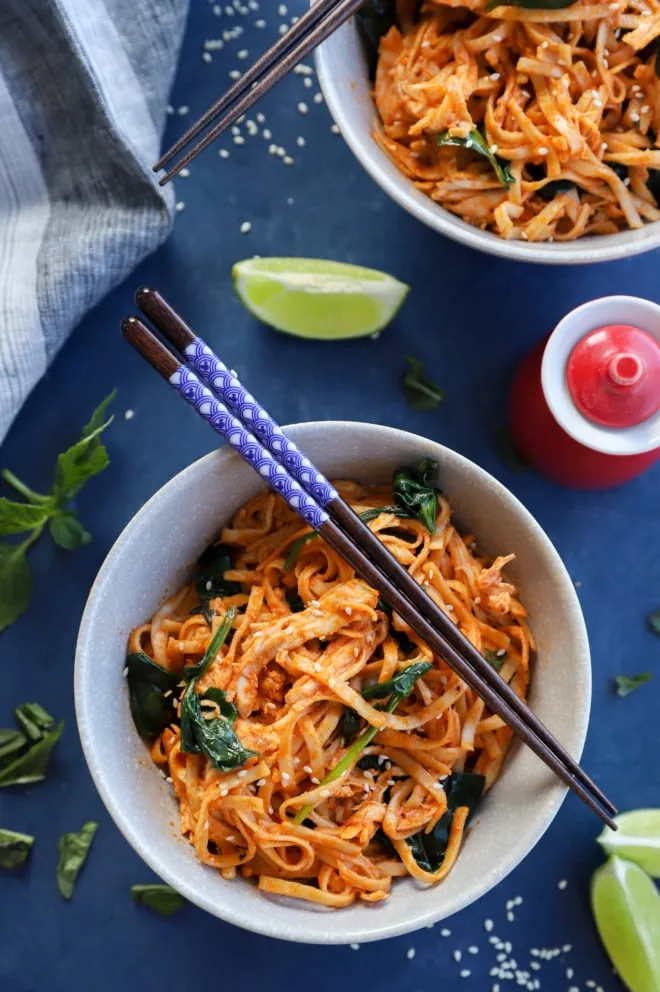
about these gochujang noodles
Looking for an easy, flavorful meal that packs a punch? These gochujang noodles are just what you need! They’re quick to make and full of spicy, saucy flavor.
For those of you who are looking to venture beyond you’re everyday bowl of noodles, diving into this Korean-inspired meal is easier than you think.
With a few key ingredients, you can turn up the heat on your dinner routine while also opening the door to a new food world!
These saucy gochujang noodles are perfect for a weeknight meal when you don’t have a lot of time to spend in the kitchen.
I love a basic meal like this because it’s also a fantastic place to start building the flavors. This meal is super customizable by adjusting the heat level, using different proteins, changing up the noodles, and even incorporating a variety of your favorite vegetables.
It’s a fantastic way to start intuitive cooking with a base recipe that can easily be expanded on. Plus, when a recipe takes only 15 minutes, it’s the kind of meal you can slow down for 5 minutes to truly adjust the sauce to your personal preference!
If you are looking for another weeknight-friendly noodle dish, don’t miss out on this curry udon made with chicken and onions!
Let’s break down the ingredients for this recipe, shall we?
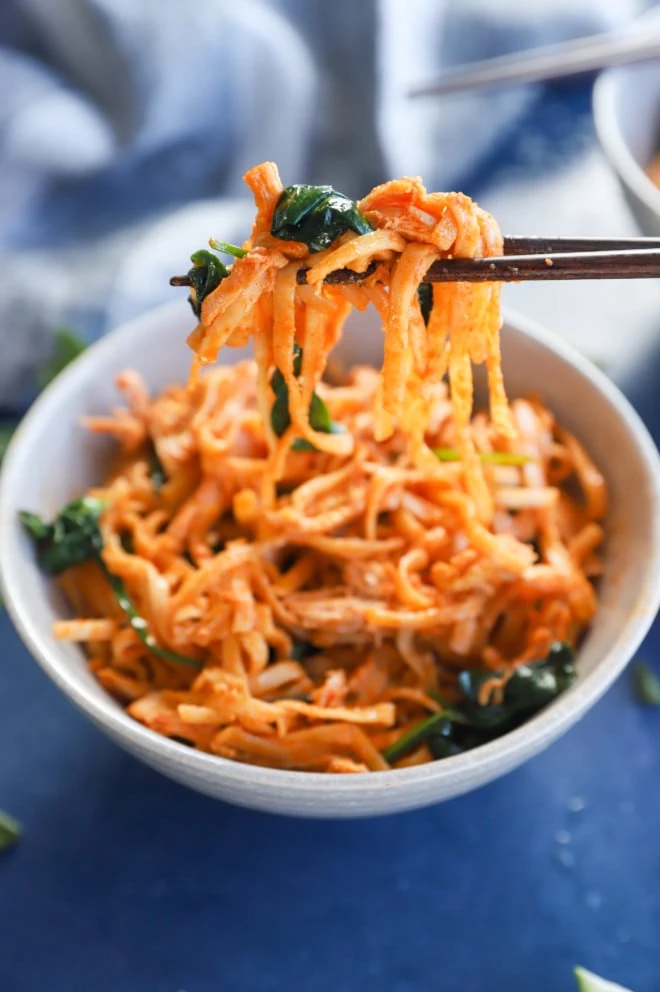
what is gochujang?
Gochujang is a fermented Korean chili paste. The fermented chili paste is a combination of spicy, sweet, and savory. Bright red and sticky, this thick paste is used as a condiment, but also as a star in sauces in Korean cooking.
ingredients
noodles. I used lo mein noodles here, but any fresh or dried wheat noodles will work. Options include udon and ramen as well.
gochujang. Be sure to use gochujang paste and not gochujang sauce. The paste is more pungent, which is why it brings so much flavor to this dish!
soy sauce. Use your favorite soy sauce! You can also use tamari if you prefer.
sugar. All you need is light or dark brown sugar.
tahini. Tahini is made from sesame, which makes it an ideal flavor pairing for this recipe!
lime juice. Fresh lime juice is always best!
oil. You will need both sesame oil and vegetable oil for this recipe.
garlic. Use whole garlic cloves or save yourself a step and buy that minced garlic that I’m always talking about.
spinach. Fresh spinach leaves are best for this recipe! You can use frozen as well. If you do, be sure to thaw them and squeeze out all of the excess water. Add to the dish at the very end of cooking, as you will not need to cook the spinach until it wilts.
chicken. I just grab a rotisserie chicken and shred the meat to add to this recipe. Alternatively, make your own with a smoked chicken or grilled full chicken. You can also make your own shredded chicken, or use a different meat entirely. You could use beef, pork, tofu, or skip a protein altogether if you don’t have any on hand. See my Variations section for more information on that.
basil. Fresh basil is best! Simply hand tear the leaves and throw them in.
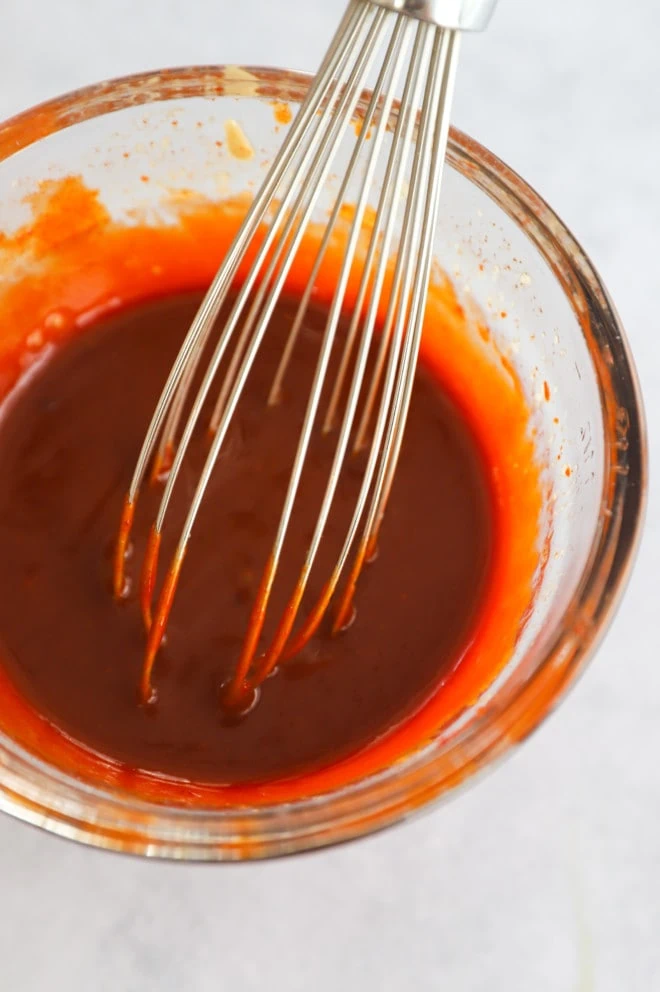
where can I buy gochujang?
I find gochujang in the Asian foods aisle at my local supermarket. I haven’t had a problem finding it at the major retailers in my city, but if you do have trouble tracking it down there, you can head to your local international or Asian market. It’s become pretty darn mainstream lately so it’s easier to find than it was years ago!
this recipe’s must haves
This recipe is so darn simple and easy, all you need are your basic cooking tools.
You will need a saucepan or large pot to cook the noodles.
Use the smallest of your mixing bowls and a whisk to make the sauce.
Finally, cook everything together in a wok or a large skillet. I like to grab a pair of tongs or clongs to toss it all together at the end.
here’s how to make gochujang noodles
cook noodles
Bring a pot of salted water to a boil over high heat. Cook noodles according to the package instructions. Drain and rinse under cold water.
make sauce
While the noodles are cooking, whisk together gochujang paste, soy sauce, brown sugar, tahini, sesame oil, and 2 Tablespoons water in a small bowl until well combined.
Taste the sauce now! This is where you can adjust the flavoring to make it spicier, add more salt with soy sauce, or even add a touch of acid if you like with a teaspoon or two of lime juice. If you want more umami flavor, add in a little more tahini or you can add in some more sugar if it’s too acidic.
put it all together in a skillet
Heat oil in a wok or large skillet over medium-high heat. Once hot, add garlic and cook until fragrant, about 30 seconds. Add sauce and, stirring constantly, cook until thickened, about 2 minutes.
Add noodles, spinach, chicken, and basil. Toss together and cook until spinach is wilted, about 2 minutes.
Serve immediately. The longer the noodles sit the stickier they will get! Garnish with sesame seeds and sliced scallions, if desired.
Pro Tip: If the sauce is too thick, add a little bit of water to the pan to loosen up the sauce.
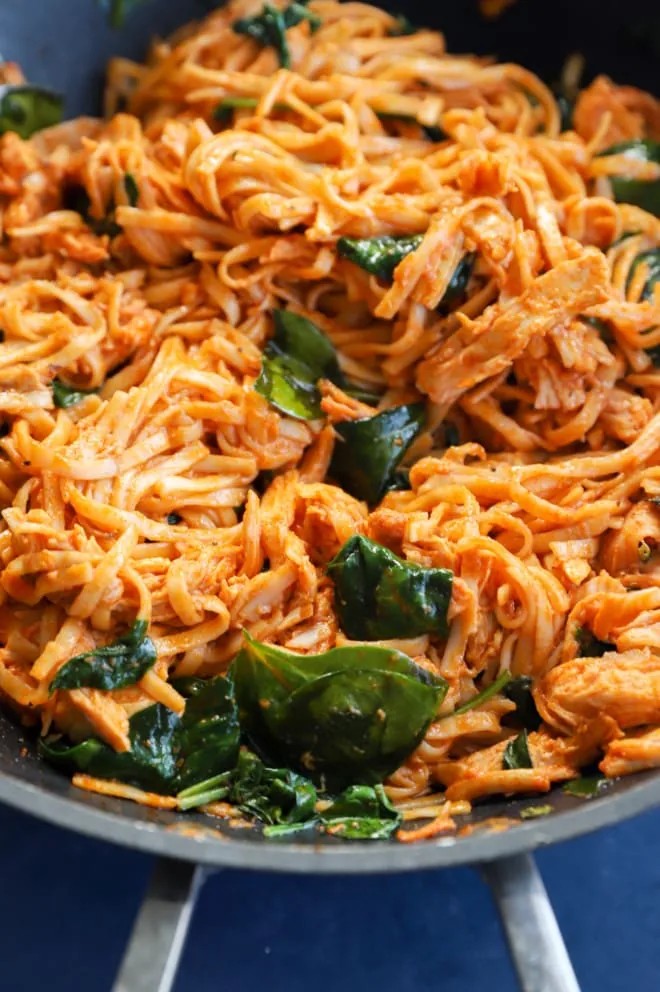
variations
There are SO many variations for these noodles! Here are our favorite ways to enjoy the dish:
- Swap out cooked shredded chicken for shredded skinless chicken thighs, ground beef, pulled pork, or ground turkey. You can even make it vegetarian by using tofu.
- Add in additional sautéed veggies like carrots, zucchini, bell pepper, jalapeños, broccoli, cabbage, bok choy, snap peas, and more to make it like a stir fry.
- Swap out the spinach for chopped kale or another leafy green.
- Don’t have tahini? Try using peanut butter for a fun spin on the flavor of this sauce. It will give you a nutty flavor just like tahini, but with a peanut finish instead of sesame.
- Use different noodle shapes! I used lo mein noodles, but you can also use udon noodles or ramen noodles. If you want to make it gluten-free, you can even use rice noodles. You could even use zucchini noodles if you want!
- Top it with a fried egg for extra protein – a runny yolk makes anything better really.
More ways to explore Korean-inspired flavors: Korean Turkey Lettuce Wraps | Korean Spicy Chicken Rice Bowls | Crispy Korean BBQ Chicken Wings | Spicy Korean Chicken Thighs | Kimchi Udon
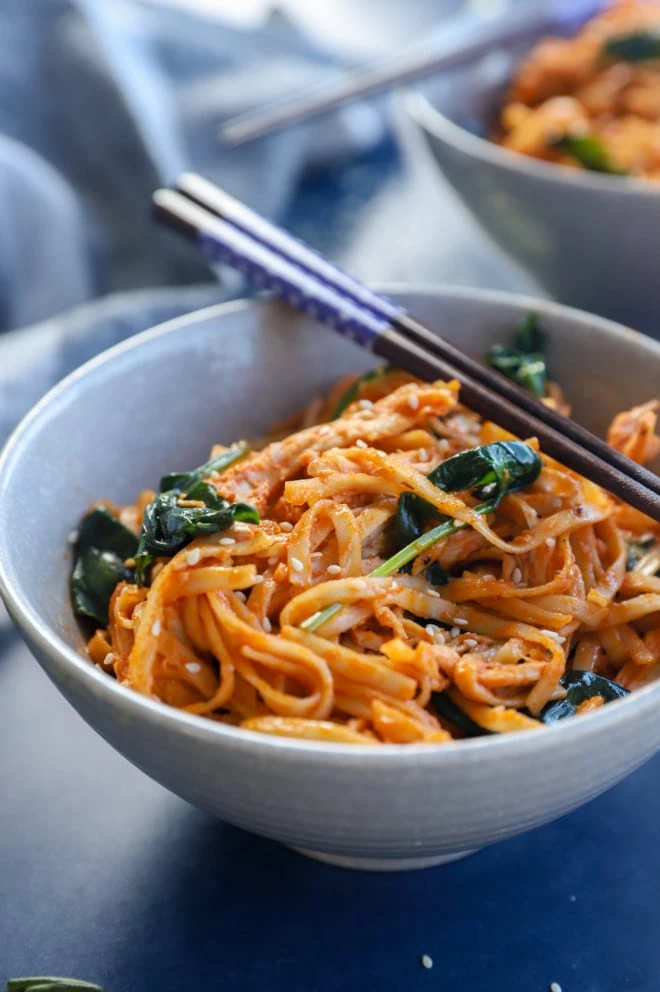
can I make this vegetarian?
Of course! Simply replace the cooked chicken with your favorite vegetarian protein, like tofu or seitan. You can also simply omit the protein entirely and add in additional sautéed vegetables to make the noodle dish heartier for your family.
can I double this recipe?
Yes you can! Be sure that you are using your largest wok or skillet because you’ll have a lot of food on your hands. This dish is delicious for the next couple of days, so it’s a fantastic way to make dinner for the family and end up with lunches for yourself for a couple of days. See my notes below on how to reheat as the noodles can get stickier the longer they sit. All you need is a little water to fix the problem!
how spicy are these noodles?
They definitely have a kick thanks to the gochujang paste! It’s a medium heat so it won’t light your tastebuds on fire, but it’s present. You can always add more if you like it really spicy!
Note that if you are concerned about the spice level, you can also take away some of the gochujang paste if you are afraid of it being too spicy. Thankfully you make the sauce before adding it to the other elements! Taste it first, then adjust seasoning to taste.
what’s the difference between gochujang paste and gochujang sauce?
Gochujang paste (the ingredient used in this recipe) is a thicker, spicier, and more potent mixture than gochujang sauce. Gochujang sauce is mixed with other ingredients and is overall thinner in consistency. Be sure to use the paste for this recipe!
Need more inspiration for noodle dishes? Check out my pasta recipes page!
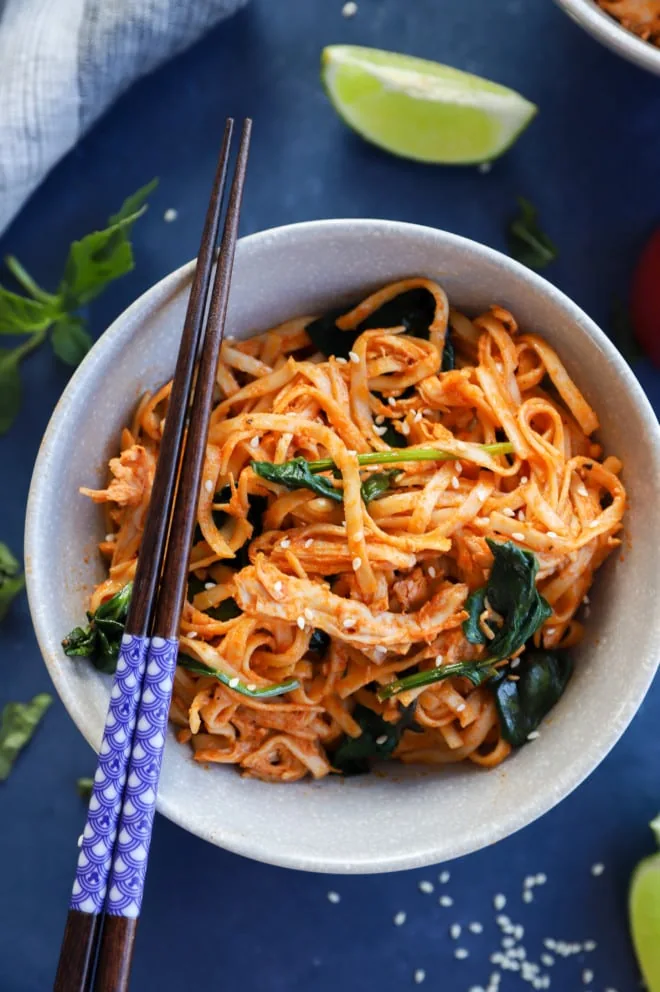
what to serve with gochujang noodles
When it comes to serving these spicy gochujang noodles, I love to serve up all the topping options for myself and my family! My son and I love to add extra fresh squeezed lime juice on top. Here’s everything else you can put out on the table:
- Soy sauce
- Toasted sesame seeds
- Sesame oil
- Freshly chopped basil, but you can also use cilantro, chives, green onions, or all of these together!
- Sriracha or gochujang sauce (if you need more heat!)
- Chili oil
I don’t serve this dish with any sides because everything is right in the bowl of noodles! However, you could also kick off the meal with spring rolls or potstickers if you want to keep in the theme of an Asian-style meal.
If you are looking for a super easy dessert to end the meal with, try these three ingredients nutella cakes!
how to store and reheat
Store. To store these noodles, simply place in an airtight container and place in the refrigerator. I recommend eating leftovers within 1 to 2 days as the noodles get stickier the longer they sit.
Freeze. I do not recommend freezing this recipe.
Reheat. Reheat in the microwave until warmed through. If the noodles are sticky, add a little bit of water to loosen up the sauce.
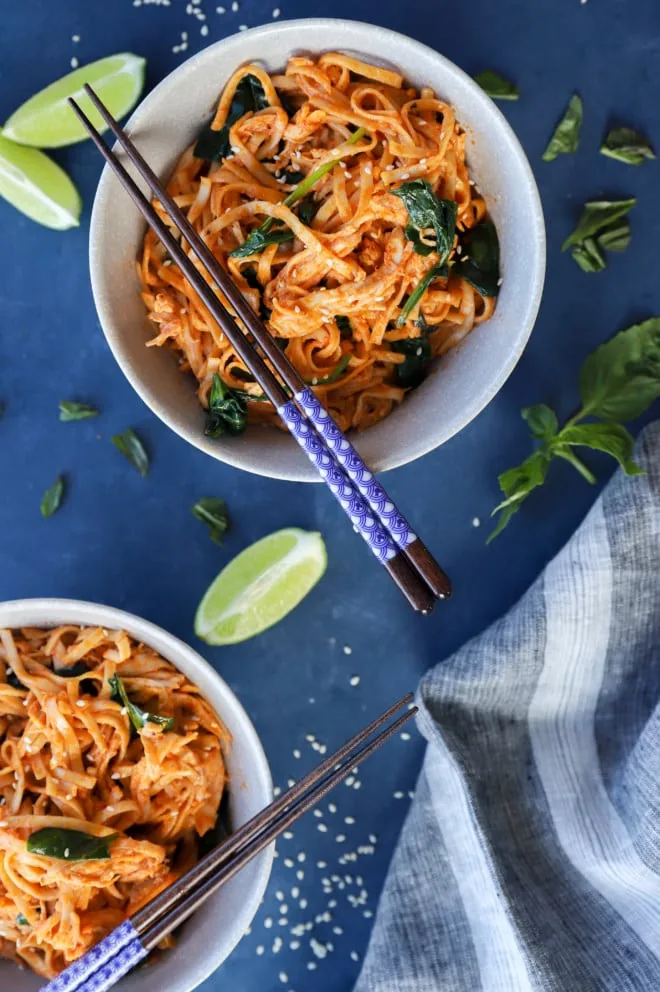
Finally, if you make this gochujang noodles recipe, please be sure to give this recipe a star recipe rating on the recipe card and/or leave a comment! I love to hear when you all make recipes, and I do take the time to respond to every single comment.
Feel free to drop questions below too, if you have them!
Oh and be sure to tag me on Instagram, Facebook, or Pinterest if you make the recipe! I love being able to see these recipes come to life in your homes – it’s my favorite thing to look through those photos. It really means the world to me!
Want to know when I come out with a new recipe or the latest news? Sign up for my newsletter!
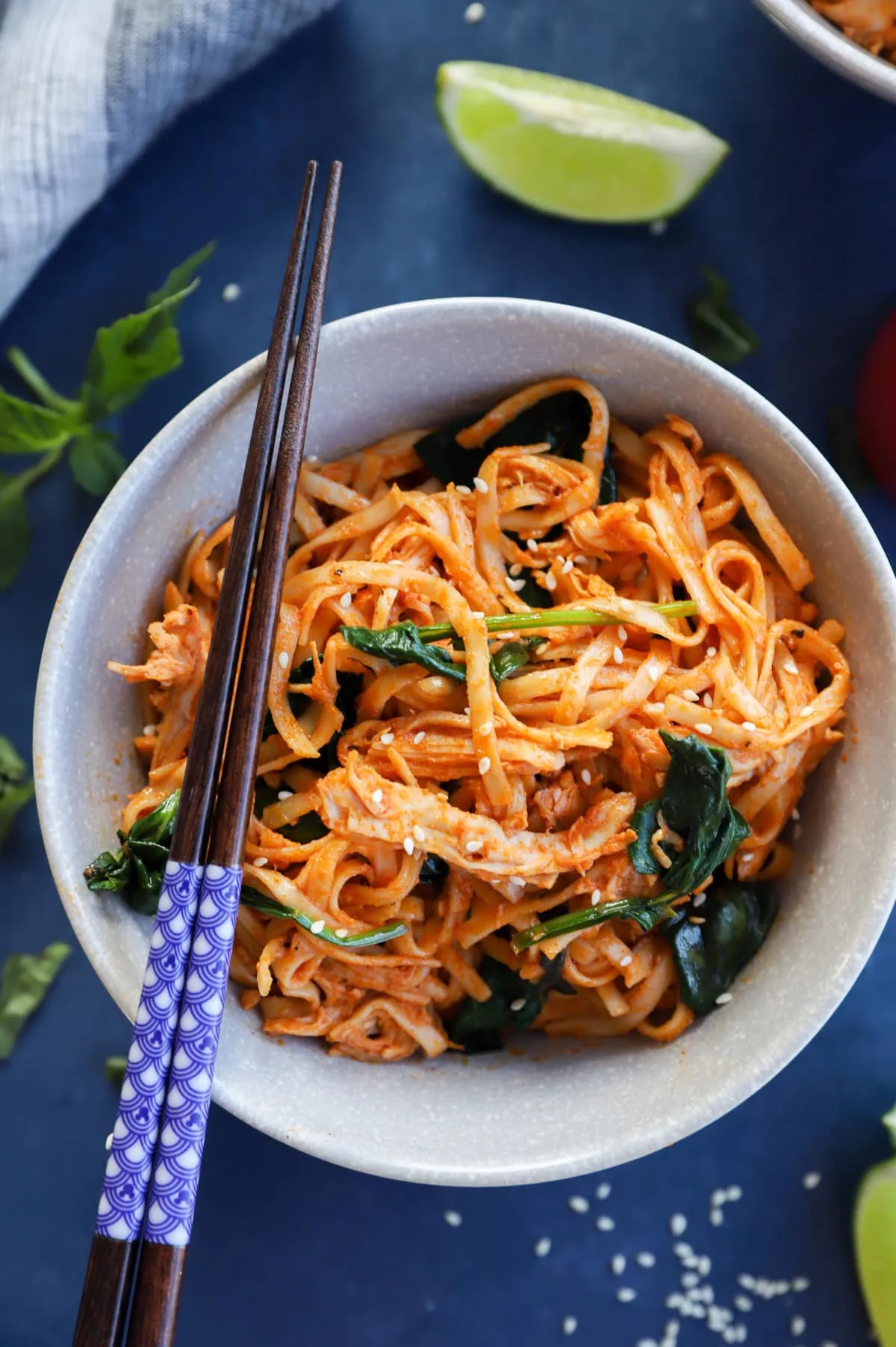
gochujang noodles
equipment
ingredients
- 8 to 10 oz fresh or dried wheat noodles such as lo mein, udon, or ramen
- 1/4 cup gochujang
- 1/4 cup soy sauce
- 2 Tbsp light or dark brown sugar
- 2 Tbsp tahini
- 1 1/2 Tbsp fresh lime juice
- 2 tsp toasted sesame oil
- Salt and pepper
- 2 Tbsp vegetable oil
- 4 garlic cloves finely chopped
- 1 1/2 cups loose-packed fresh spinach
- 1 lb shredded chicken homemade or rotisserie chicken works great here!
- Handful of torn basil leaves plus sprigs for serving
- For serving: fresh basil leaves lime wedges, salt, chili oil, sesame seeds, sesame oil, etc.
instructions
- Bring a pot of salted water to a boil over high heat. Cook noodles according to the package instructions. Drain and rinse under cold water.
- While the noodles are cooking, whisk together gochujang paste, soy sauce, brown sugar, tahini, sesame oil, and 2 Tablespoons water in a small bowl until well combined.
- Taste the sauce now! This is where you can adjust the flavoring to make it spicier, add more salt with soy sauce, or even add a touch of acid if you like with a teaspoon or two of lime juice. If you want more umami flavor, add in a little more tahini or you can add in some more sugar if it’s too acidic.
- Heat oil in a wok or large skillet over medium-high heat. Once hot, add garlic and cook until fragrant, about 30 seconds. Add sauce and, stirring constantly, cook until thickened, about 2 minutes.
- Add noodles, spinach, chicken, and basil. Toss together and cook until spinach is wilted, about 2 minutes.
- Serve immediately with your preferred toppings.
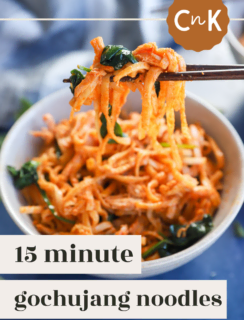
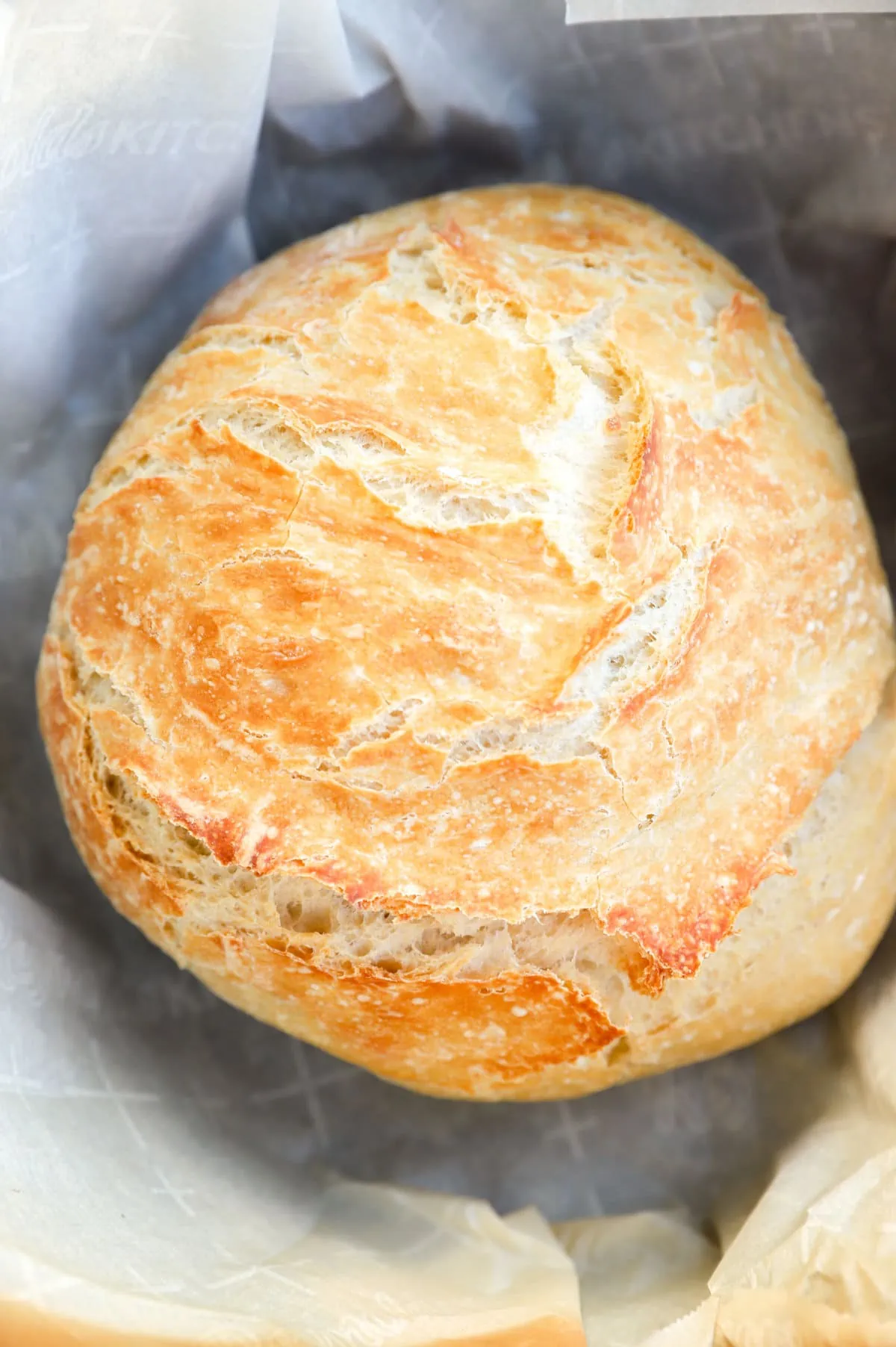

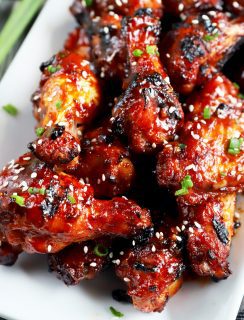
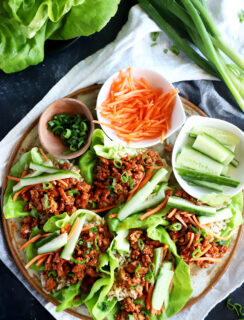
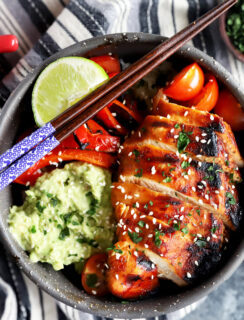
SUZ says
Really great recipe! I sautéed up some boneless, skinless chicken thigh with salt, pepper and minced garlic. Delicious dinner!
Meghan Y. says
So glad you enjoyed it!!
Ethel says
This is so good and easy to make.I love that you can always adjust the spiciness with the amount of gochujang.I made this when we had a samgyupsal party. Went well with the grilled pork and beef.
Dana says
I love the combination of gochujang and chicken, and this noodle dish did not disappoint. So full of flavor, but super quick and easy to put together. Even my youngest, who is averse to the smallest bit of spice, came back for a second try!
jennifer says
SO easy and tasty! Love how the spice heat can be adjusted — I take out my serving (I’m a heat whip) and then add more gochujang for my heat-loving hubby!
Sage Scott says
I’m embarrassed to admit that I didn’t know what gochujang was until a recent trip to California. Now that I’ve tried it, I’m addicted, and these amazing noodles with chicken and greens were another way to enjoy this new fav flavor.
Dianne says
I made a vegetarian version of this dish using tofu instead of chicken, and it turned out fantastic! The tofu soaked up all the delicious sauce.